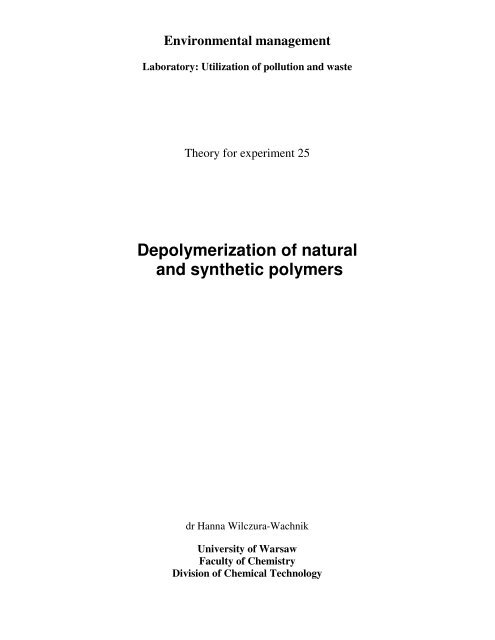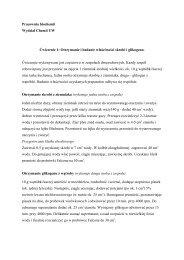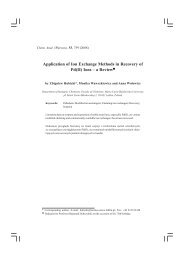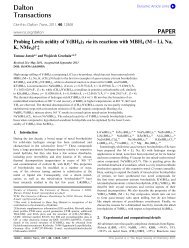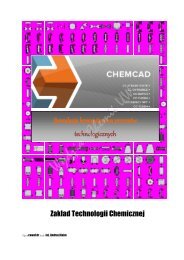Depolymerization of natural and synthetic polymers
Depolymerization of natural and synthetic polymers
Depolymerization of natural and synthetic polymers
Create successful ePaper yourself
Turn your PDF publications into a flip-book with our unique Google optimized e-Paper software.
Environmental management<br />
Laboratory: Utilization <strong>of</strong> pollution <strong>and</strong> waste<br />
Theory for experiment 25<br />
<strong>Depolymerization</strong> <strong>of</strong> <strong>natural</strong><br />
<strong>and</strong> <strong>synthetic</strong> <strong>polymers</strong><br />
dr Hanna Wilczura-Wachnik<br />
University <strong>of</strong> Warsaw<br />
Faculty <strong>of</strong> Chemistry<br />
Division <strong>of</strong> Chemical Technology
Theoretical background<br />
The word polymer means a large molecule (macromolecule) composed <strong>of</strong><br />
repeating structural units called mers. These subunits are typically connected by<br />
covalent chemical bonds. Although the term polymer is sometimes taken to refer to<br />
plastics, it actually encompasses a large class comprising both <strong>natural</strong> <strong>and</strong> <strong>synthetic</strong><br />
materials with a wide variety <strong>of</strong> properties.<br />
Commonly the macromolecule is defined as the molecule with at least 2000 atoms.<br />
The number <strong>of</strong> repeating units (mers) in a given macromolecule is called a degree <strong>of</strong><br />
polymerization. Degree <strong>of</strong> polymerization can be calculated according to the following<br />
relation:<br />
−<br />
P =<br />
−<br />
M<br />
M m<br />
−<br />
M is polymer molecular weight <strong>and</strong> Mm is monomer molecular weight. The<br />
where:<br />
numerical value <strong>of</strong> degree <strong>of</strong> polymerization is considering as the limit dividing<br />
−<br />
molecules on oligomers ( P ≤ 1000 ) <strong>and</strong> <strong>polymers</strong> with P > 1000 .<br />
Basically there are two types <strong>of</strong> macromolecules: <strong>synthetic</strong> <strong>polymers</strong> <strong>and</strong><br />
biological <strong>polymers</strong>. As a <strong>synthetic</strong> <strong>polymers</strong> are classified those that do not exists in<br />
nature; they are man-made molecules. Biological <strong>polymers</strong> do exists in nature, but<br />
they can also be synthesized in the laboratory.<br />
Polymers are studied mainly in the fields <strong>of</strong> the following polymer sciences:<br />
polymer chemistry <strong>and</strong> polymer physics.<br />
Polymers play an essential <strong>and</strong> ubiquitous role in everyday human life<br />
because <strong>of</strong> the extraordinary range <strong>of</strong> properties. From familiar <strong>synthetic</strong> plastics <strong>and</strong><br />
elastomers to <strong>natural</strong> bio<strong>polymers</strong> such as nucleic acids <strong>and</strong> proteins that are<br />
essential for life. As a <strong>natural</strong> polymeric materials are classified also shellac, amber,<br />
cotton <strong>and</strong> <strong>natural</strong> rubber which have been used for centuries. To <strong>natural</strong> <strong>polymers</strong><br />
belong polysaccharides <strong>and</strong> cellulose which is the main constituent <strong>of</strong> wood <strong>and</strong><br />
paper. The list <strong>of</strong> <strong>synthetic</strong> <strong>polymers</strong> is longer. It contains the following: <strong>synthetic</strong><br />
rubber, neoprene, nylon, PVC, polystyrene, polyethylene, PVB, silicone,<br />
polypropylene, polyacrylonitrile <strong>and</strong> other.<br />
Synthetic polymer chains commonly consist mainly <strong>of</strong> carbon atoms. The<br />
simple example <strong>of</strong> this macromolecule is polyethylene obtaining in ethylene<br />
polymerization (Figure 1). A repeating unit in polyethylene is based on ethylene<br />
monomer.<br />
Figure 1. The polymerization <strong>of</strong> ethylene in to poly(ethylene).<br />
−<br />
2
Examples <strong>of</strong> repeating unit s <strong>of</strong> other polymer chains are shown in Figure 2.<br />
Figure 2. The repeating unit <strong>of</strong> some polymer chains.<br />
Taking into account the polymer chain structure <strong>polymers</strong> are classified into<br />
two structural categories: linear <strong>polymers</strong> (a single backbone without branches) <strong>and</strong><br />
branched <strong>polymers</strong>. Linear polymer chain is in the form showing on Figure 3 where A<br />
is the basic structural unit, x is the degree <strong>of</strong> polymerization <strong>and</strong> A ’ <strong>and</strong> A ’’ are called<br />
the end groups.<br />
Figure 3. Linear <strong>polymers</strong> form<br />
Branched polymer chain is in the form presented on Figure 4. Branched polymer<br />
chain is constituent with a main chain in which are present one or more substituent<br />
side chains or branches.<br />
3
Figure 4. Branched <strong>polymers</strong> form<br />
To branched type <strong>of</strong> <strong>polymers</strong> belong star, comb, brush <strong>and</strong> dendronized <strong>polymers</strong><br />
as well dendrimers. The most well-known branched <strong>polymers</strong> are shown on Figure 5.<br />
Examples are star-shaped <strong>and</strong> comb-shaped polystyrene.<br />
a) b)<br />
Figure 5. a) the star-shaped polymer, b) the comb-shaped polymer.<br />
In terms <strong>of</strong> repeating units (mers) <strong>polymers</strong> are classified into two types:<br />
homo<strong>polymers</strong> <strong>and</strong> co<strong>polymers</strong>. A homopolymer is one in which only one monomer<br />
constitutes the repeating units. The examples <strong>of</strong> homopolymer are: polystyrene,<br />
polyethylene, polyvinyl chloride.<br />
A copolymer consists <strong>of</strong> two or more different monomers as repeating units, such as<br />
the diblock copolymer:<br />
<strong>and</strong> the r<strong>and</strong>om or static copolymer:<br />
An example is the polystyrene-poly(methyl methacrylate) copolymer.<br />
In terms <strong>of</strong> stereoregularity <strong>synthetic</strong> <strong>polymers</strong> may have trans <strong>and</strong> gauche<br />
forms, similar to some small molecules (e.g., ethane). Because <strong>of</strong> the steric position<br />
<strong>of</strong> substituents along the chain, the heterogeneity <strong>of</strong> the chain structure may be<br />
classified into atactic, isotactic <strong>and</strong> syndiotactic forms. Examples <strong>of</strong> these forms are<br />
presented in Figure 6.<br />
a)<br />
4
c)<br />
b)<br />
Figure 6. The heterogeneity <strong>of</strong> the chain structure: a) atactic polymer - no<br />
regularity <strong>of</strong> R groups; b) isotactic polymer – regularity <strong>of</strong> R groups; c) syndiotactic<br />
polymer – regularity involves trans <strong>and</strong> gauche forms in a uniform manner.<br />
Synthetic <strong>polymers</strong> that are commercially manufactured in the quantity <strong>of</strong><br />
billions <strong>of</strong> kilos may be classified in three categories plastics (including<br />
thermoplastics), <strong>synthetic</strong> fibers <strong>and</strong> <strong>synthetic</strong> rubber.<br />
To plastics are classified <strong>polymers</strong> which include thermosetting resins (e.g.,<br />
urea resins, polyeters, epoxides as well as thermoplastic resins (e.g., low-density as<br />
well as high-density polyethylene, polystyrene, <strong>and</strong> polypropylene.<br />
As <strong>synthetic</strong> fibers, <strong>polymers</strong> which include cellulosic (such as rayon<strong>and</strong><br />
acetate) <strong>and</strong> nonlellulose (such as polyester <strong>and</strong> nylon;<br />
To the last category, <strong>synthetic</strong> rubber belong the following examples <strong>of</strong><br />
polymer: styrene-butadiene copolymer, polybutadiene, ethylene-propylene<br />
copolymer).<br />
In 1929 Carothers classified <strong>synthetic</strong> <strong>polymers</strong> into two basic classes<br />
according to the method <strong>of</strong> preparation: addition <strong>polymers</strong> <strong>and</strong> condensation<br />
<strong>polymers</strong>. Addition <strong>polymers</strong> (also called chain reaction <strong>polymers</strong>) are formed in a<br />
chain reaction <strong>of</strong> monomers which have double bonds. On Figure 7 examples <strong>of</strong><br />
addition <strong>polymers</strong> are presented<br />
5
Figure 7. Examples <strong>of</strong> addition <strong>polymers</strong>.<br />
Condensation <strong>polymers</strong> (called stepwise reaction <strong>polymers</strong>) are the products<br />
<strong>of</strong> the reaction occurring between two polyfunctional molecules by eliminating a small<br />
molecule, for example, water. Examples <strong>of</strong> condensation <strong>polymers</strong> are given in<br />
Figure 8.<br />
Figure 8. Examples <strong>of</strong> condensation <strong>polymers</strong>.<br />
6
Polymerization is the name <strong>of</strong> reaction <strong>of</strong> combining a many monomer<br />
molecules into a covalently bonded chain without presence low molecular weight<br />
products like water. Such a continuously linked polymer chain consists mainly <strong>of</strong><br />
carbon atoms. The simplest example <strong>of</strong> <strong>synthetic</strong> <strong>polymers</strong> is polyethylene. The<br />
repeating unit in this polymer is based on ethylene monomer. In polymer backbones<br />
except carbon atoms also oxygen ones are present, for example in polyethylene<br />
glycol.<br />
Commonly polymerization reactions are divided on chain polymerization <strong>and</strong><br />
stepwise polymerization. In a chain polymerization are present the steps: initiation,<br />
chain propagation <strong>and</strong> termination. Contrary, in stepwise polymerization, there is no<br />
initiation, propagation or termination.<br />
Stepwise polymerization<br />
The polymerization depends entirely on the individual reactions <strong>of</strong> the functional<br />
groups <strong>of</strong> monomers. The four types <strong>of</strong> stepwise polymerization are the synthesis <strong>of</strong><br />
polyester, polyamide, polyurethane <strong>and</strong> polycarbonate. The examples <strong>of</strong> stepwise<br />
polymerization are given below:<br />
1. Polyester synthesis– by the direct reaction <strong>of</strong> a diacid <strong>and</strong> a diol at high<br />
temperatures. The example given below is the synthesis <strong>of</strong> Dacron:<br />
2. Polyamide synthesis – using two difunctional monomers. As example is the<br />
synthesis <strong>of</strong> 66 nylon:<br />
7
3. Polyurethanes (polycarbamates) synthesis – by the reaction <strong>of</strong> a diisocyanate with<br />
a diol. Reactions are usually carried out in solutions. The example <strong>of</strong> polyurethane<br />
synthesis is the following:<br />
4. Polycarbonate synthesis – by the reaction <strong>of</strong> the simplest diacidchloride,<br />
phosgene, with bisphenol A in the presence <strong>of</strong> a base. An example <strong>of</strong> reaction is<br />
given below:<br />
The chain polymerization depending on the mechanism <strong>of</strong> the reactions is<br />
classified as: radical polymerization <strong>and</strong> ionic polymerization.<br />
8
Radical polymerization<br />
The reaction scheme for free-radical polymerization can be expressed as follows:<br />
Initiation Initiator → R•<br />
Chain propagation<br />
R• + M → MR•<br />
MR• + M → M2R•<br />
Chain termination Mn R• + Mm R• → Mn+m<br />
where M represents a monomer molecule <strong>and</strong> R• a free radical produced in the<br />
initial step.<br />
An example <strong>of</strong> free-radical polymerization is the synthesis <strong>of</strong> polyethylene.<br />
Initiation:<br />
Propagation:<br />
Termination:<br />
9
Most <strong>of</strong> the initiators used in the free-radical polymerization are aliphatic azo<br />
compounds <strong>and</strong> peroxides such as the following:<br />
Methods <strong>of</strong> free-radical polymerization are the following:<br />
1. bulk polymerization – synthesis without solvent<br />
2. solution polymerization – synthesis with (inert) solvent<br />
3. precipitation polymerization – using solvent (such as methanol) to precipitate<br />
out the polymer<br />
4. suspension polymerization – adding an initiator to the suspension in aqueous<br />
solution<br />
5. emulsion polymerization – adding an initiator (such as potassium persulfate) to<br />
the emulsion <strong>of</strong> water insoluble monomers (such as styrene) in aqueous soap<br />
solution.<br />
Ionic polymerization<br />
There are two types <strong>of</strong> ionic polymerization: anionic <strong>and</strong> cationic. The formers<br />
involve carbanons C - <strong>and</strong> the later involves cabonium C + ions. Catalysts <strong>and</strong><br />
cocatalysts are needed in ionic polymerization.<br />
In anionic polymerization as catalysts are used: alkali metals, alkali metal<br />
amides, alkoxides, <strong>and</strong> cyanides. The cocatalysts usually are: organic solvents, such<br />
as heptane. Below the synthesis <strong>of</strong> polystyrene as an example <strong>of</strong> anionic<br />
polymerization is given.<br />
Initiation:<br />
10
Propagation:<br />
Termination:<br />
Depending on catalysts the chain growth in anionic polymerization can go through<br />
two, three four or more directions not only in one direction as shown in the above<br />
example.<br />
In cationic polymerization as catalysts are used Lewis acids <strong>and</strong> Friedel-Crafts<br />
catalysts such as BF3, AlCl3, <strong>and</strong> SnCl4 <strong>and</strong> strong acids such as H2SO4. The<br />
cocatalysts are needed also. Usually there are: water <strong>and</strong> isobutene. Below the<br />
synthesis <strong>of</strong> polyisobutene as an example <strong>of</strong> cationic polymerization is given.<br />
Initiation:<br />
11
Propagation:<br />
Termination:<br />
Polymer degradation <strong>and</strong> depolymerization<br />
Polymer degradation is mainly caused by chemical bond scission reactions in<br />
macromolecules. It does not appear meaningful therefore, to distinguish between<br />
different modes <strong>of</strong> polymer degradation. For practical reason, however, it is useful to<br />
subdivide the polymer degradation according to its various modes <strong>of</strong> initiation. There<br />
are: thermal, mechanical, photochemical, radiation chemical, biological <strong>and</strong> chemical<br />
degradation <strong>of</strong> polymeric materials. Modes <strong>of</strong> polymer degradation in details are<br />
described in theoretical background for experiment 20 (www. ).<br />
The peculiar process category causing changes in macromolecules <strong>and</strong><br />
plastics is depolimerization (is the process converting polymer into a monomer,<br />
mixture <strong>of</strong> monomers or oligomer). According to definition, depolimeryzation it is a<br />
process <strong>of</strong> polymer chain decomposition till monomers or oligomers which undergo at<br />
high temperature or hydrolytic agents. So, there are distinguishing thermal <strong>and</strong><br />
chemical depolymerization suitable.<br />
Commonly, as thermal depolymerization is classified chemical reaction in<br />
which polymer chain converses to monomer at high temperature. The monomer yield<br />
in this reaction is satisfied for a few <strong>polymers</strong> only. As an example can be given<br />
produced in commercial scale methyl polymethacrylate (PMMA), polystyrene (PS) as<br />
well as methacrylate resins (ethyl- <strong>and</strong> buthyl polymethacrylate) produced in smaller<br />
scale. <strong>Depolymerization</strong> occurs during thermal decomposition <strong>of</strong> poly<br />
(dimethylsiloxanes) too. There are formed cyclic oligomers, mainly<br />
hexamethyltrisiloxane. Such oligomers are used as monomers in polysiloxanes<br />
synthesis. It is necessary to underline that during heating bulk <strong>of</strong> <strong>polymers</strong><br />
degradates instead depolymerization.<br />
12
Common regularity is that thermal depolymerization undergoes additive<br />
<strong>polymers</strong> (yields in addition polymerization). Contrary, polycondensation <strong>polymers</strong><br />
don’t depolymerize thermally.<br />
Below are given example <strong>of</strong> thermal depolymerization <strong>of</strong> some <strong>polymers</strong>:<br />
- thermal depolymerization <strong>of</strong> polystyrene (yield ~70%) undergoes according to<br />
relation:<br />
- thermal deplymerization <strong>of</strong> methyl polymethacrylate (yield 90%) undergoes<br />
according to relation:<br />
Chemical depolymerization point is that chemical compounds containing active<br />
hydrogen atoms react with polar groups in the main chains <strong>of</strong> polycondensate<br />
(condensation polymer). Usually, this reaction goes as acid or basic hydrolysis <strong>of</strong><br />
amide, ester or urethane bonds.<br />
Poly(ethylene terephthalate) PETP is the polymer mainly treated with the<br />
chemical depolymerization. Except it, depolymerization is possible for polycarbonates<br />
<strong>and</strong> polyurethanes (mostly polyurethane foams).<br />
PETP chemical depolymerization goes as a hydrolysis at acidic medium according to<br />
relation:<br />
13
The main reaction products are monomers: terephtalic acid <strong>and</strong> ethylene glycol.<br />
In case <strong>of</strong> PETP hydrolysis in basic medium the reaction products are:<br />
ethylene glycol <strong>and</strong> sodium terephthalate according to relation:<br />
<strong>and</strong> next treating sodium terephthalate with sulphyric acid VI as a product a<br />
therephthalate acid is obtaining:<br />
:<br />
Another option <strong>of</strong> PETP depolymerization is alcoholysis (for example methanolysis –<br />
methyl alcohol action). Dimethyl terephthalate (DMT) is getting as the product. DMT<br />
is used as a monomer in PETP synthesis. The PETP methanolysis is going<br />
according to relation:<br />
14
Except given above there are possible depolymerizations under different<br />
chemical reagents as for example autooxidants such as L-ascorbic acid, iron (II)<br />
sulfate, enzymes (for example cysteine).<br />
References:<br />
1. Physical chemistry <strong>of</strong> macromolecules. Basic principles <strong>and</strong> issues. Second Editon<br />
S.F.Sun, John Wiley& Sons, Inc., 2004<br />
2. Polymer degradation. Principles <strong>and</strong> applications. W.Schnabel, Akademie-Verlag<br />
Berlin, 1981<br />
3. Thermal stability <strong>of</strong> <strong>polymers</strong>. Vol.1 Ed. By Robert T.Conley, New York 1970<br />
4. Aspects <strong>of</strong> degradation <strong>and</strong> stabilization <strong>of</strong> <strong>polymers</strong>. Ed. By H.H.G.Jellinek,<br />
Elsevier, 1978<br />
15


